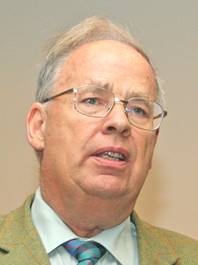October 4, 2010
Searching for Life on other Planets
Prof Ian Morison
Report by: Roger Geeson
On 4th October, a very large audience of Flamsteed members was delighted to listen avidly to Prof. Ian Morison’s update on the SETI investigation (the Search for Extra Terrestrial Intelligence) and to receive his personal views on the probable outcome of this ongoing research.
Thanks to the tube strike, Ian joined us after a five hour journey from Manchester, courtesy of five different rail companies! He opened his discourse with a modest plug for the monthly lectures at the Museum of London which he gives as part of his continuing appointment as the Gresham College Professor of Astronomy. Ian gave us a brief history of Gresham College which has existed for over 400 years since its inception by Sir Thomas Gresham to provide free public lectures. It is sponsored by the worshipful Company of Mercers and the Corporation of London and espouses seven ancient Professorships, of Astronomy, Divinity, Geometry, Law, Music, Physic and Rhetoric.
Moving to the SETI problem Prof. Morison spoke of two enigmas, the first being the physical difficulty of detecting forms of intelligence and secondly, the question of the probability that forms of intelligence exist elsewhere in the Universe at all. He recalled that Carl Sagan had once postulated the possible the presence of up to one million alien life forms!
Ian reviewed the possibility of life on other planets in the Solar System. Historically, much excitement was kindled by the ‘discovery’ of canals on Mars, (since shown to be an illusion by observation with more sophisticated telescopes) and much later by the data feedback from the Viking landers in 1976, and the remarkable observations and pictures transmitted by the Spirit and Opportunity rovers. Prof. Morison recalled his pride at being asked to track the ill-fated Beagle probe with the Jodrell Bank radio telescope and of his bitter disappointment when the radio signals abruptly vanished without explanation just prior to the Lander’s touch down.
Since then, even more sophisticated optical equipment has been placed in Earth orbit to search for suitable ‘Exo planets’ which might support life forms, and Ian noted that some can be seen, citing the Keck telescope’s infrared observations of Formalhaut B which meets the suggested criteria. Other methods of detection of possible planets are being employed, such as seeking radial velocity Doppler effects, and also looking for transits of stars as with the Kepler mission’s detailed study of the Sigma region near the Milky Way. It is also possible to detect the presence of potentially life sustaining oxygen by examining the spectra of possible ‘Goldilocks’ planets for O2/O3 ‘spikes’ which do not exist on planets like Mars and Venus.
Ian amused his audience by recalling probably the first scientifically recorded ‘E.T.’ radio signal which was detected in 1967 by Jocelyn Bell (now Prof Dame Jocelyn Bell Burnell) and which she recorded in her notes as ‘LGM1’ (Little Green Men 1) This signal, a similar sound sample of which Ian demonstrated, was later shown to emanate from what is now known as a ‘Pulsar’.
In his conclusion to a fascinating talk, Professor Morison opined that whilst we might conceivably receive alien radio signals, the probability of any optical sightings of ETI were extremely low. However he averred, if we never searched, by either method, the chances of discovery would be absolutely zero!
Read More at —
Posted under: Flamsteed, Flamsteed Lecture, Meeting Report








You must be logged in to post a comment.